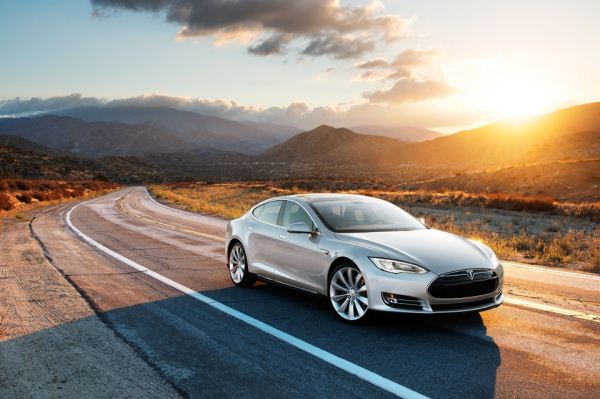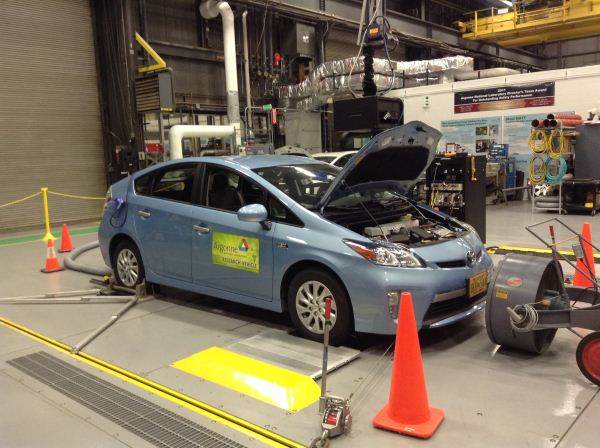The Tesla Model S Controversy: Understanding the Effects of Temperature on Electric Vehicle Efficiency and Range
by Vivek Gowri on February 18, 2013 4:22 PM EST- Posted in
- Auto
- Electric Vehicles
- Tesla Model S
- Nissan Leaf
Thus far, plenty of ink has been spilled regarding the Tesla Model S and the fallout from the New York Times article, and it even showed up in our latest podcast. I feel like my perspective on this topic, as someone who has worked in the EV space as an engineer for the last four years, as well as driving a family owned Nissan Leaf for the last year and a half, is a bit different from our editors who discussed it, as well as most of the others who have written about it.
I’m not particularly interested in getting involved with the back and forth or analyzing what either party said - I feel like the Times reporter didn’t really understand how EVs work, nor how to drive them, and I don’t really agree with Elon Musk’s Matlab data infused response (it felt too vitriolic to get across any point other than Tesla being angry about the article). And just to go back to the point about not understanding how EVs should be driven, you have to tailor your driving style to suit the powertrain in order to get the maximum out of the EV - if you don’t want to, you’re going to be disappointed. Consider it like needing to switch keyboard shortcuts when you move from Windows to OS X - it’s a slight mental recalibration that has to happen for you to use the platform to its fullest. But that’s another story for another time.
What I feel like is getting lost here is actual EV performance in cold weather, or hot weather, or really anything in the way of hard numbers. We all know that battery performance is reduced in more extreme environmental conditions, and that all cars, regardless of powertrain type, consume more energy (fuel or battery) in those extreme climates. Unfortunately, quantifying these general ideas is a bit more difficult. That’s where I come in.
Technology Background
First, a bit of background. I spent the last few months working in Argonne National Laboratory’s Advanced Powertrain Research Facility (APRF). They’re an extremely knowledgeable group of engineers and scientists whose job it is to test advanced technology vehicles in their temperature controlled dynamometer facility, which can sustain temperatures anywhere between -5 F to 100 F. Most of this research is done as a part of the Department of Energy’s Vehicle Technology Program.
Everything from pure electrics to plug-in hybrids, normal hybrids, clean diesels, direct engine turbos, and advanced transmissions (dual-clutch, CVT, etc.) go through the labs with an extended set of instrumentation to collect various speed and consumption metrics. The resulting data sets are truly comprehensive (2 million data cells for 20 minutes on the dynamometer) and allow the researchers to draw conclusions about the various powertrains and their behavior. It’s a pretty impressive setup.
The APRF has released some of the data to the public in something called the Downloadable Dynamometer Database. The D3 pages for the Nissan Leaf includes data from the three different temperatures used in EPA’s 5-Cycle fuel economy test: 20F (with a heater load), 72F (climate control off), and 95F + sun lamps (with an air conditioning load). In all cases involving heating or air conditioning, the climate control system is set to 72F. Using this data, we can take a more in depth look at what the actual penalties of environment are on efficiency and performance, and really see the impact of temperature on energy consumption and range.
Before we start, I should probably explain the terms used in the graphs that follow. UDDS is an urban driving cycle (it stands for Urban Dynamometer Driving Schedule), CS stands for cold start (the first start after the vehicle has been sitting for a number of hours), HS is hot start (any subsequent start after the vehicle has warmed up), HWY is short for HWFET or Highway Fuel Economy Test (also seen as the Highway Fuel Economy Driving Schedule or the EPA’s highway fuel economy cycle), and US06 is a supplemental federal test procedure (SFTP) to provide a more aggressive driving schedule than the relatively tame HWFET cycle. A comparison of the three driving cycles (speed versus time) is shown above.













102 Comments
View All Comments
Kjella - Monday, February 18, 2013 - link
"After all, limited gas stations didn't hamper the adoption of gas-fueled cars a century ago."That's a rather unfair comparison since it's trivial to bring extra gas with you in a can or a barrel, while there's no easy or cheap way to extend your battery range.
guidryp - Monday, February 18, 2013 - link
"Plug in hybrids make a lot more sense. "Not to me it doesn't, though I understand the initial appeal of the argument.
If I am going for a plug-in I am getting rid of the ICE components. With a PHEV, you are essentially always carrying dead weight. You are running in gas mode, pulling around a huge heavy battery of little use, or you are running in EV mode, pulling around huge heavy ICE components you aren't using, and you have the expense of the battery and the maintenance of an ICE car.
Most households are multi-car anyway. Have one pure ICE car, and one pure EV. Each of those is simpler and better suited to it's main role.
Even without a second car, the only time I drive more than 100 miles is on vacation. I could simply rent a car for that (and have many times even though I own an ICE car).
happycamperjack - Monday, February 18, 2013 - link
Thanks for the comment. I definitely think there's a market for pure EV, but for majority of the population, I just don't think they want deal with the chores that come with it especially when it's costing more and unproven in reliability. At least with plug ins, you have less things to worry about, but even that is too much to handle for a lot of the people.As for the dead weight argument, I agree,.I really think there should be more research on combining these two things together to save weight and space. Toyota did a good job with prius. I think they are the prime candidate for designing a new generation of plug ins engines that can be accepted by public.
phoenix_rizzen - Monday, February 18, 2013 - link
Or, go for the best of both worlds: a tiny, RPM-optimised diesel generator that does nothing but charge the batteries. Doesn't touch the drivetrain in any way. The Volt went about halfway down this path, but went with a gasoline engine that touches the drivetrain in certain circumstances.Diesels can be better optimised to always run "in the sweet spot" to get the most bang-for-the-buck. And, if its only used to charge the batteries, you only have to worry about a single drivetrain. Treat it like a pure-EV vehicle, since (in essence) that's what it is. You're just carrying around a very small generator for those longer trips.
Making it a plugin would just be icing.
beginner99 - Tuesday, February 19, 2013 - link
Well said. EVs just require to many compromises. Adjust driving style? Seriously? Then the charging. If you own a house and can just easily install such a station ok but at least were I live most people rent and a fix parking spot is often not included. And even if it is you will still need the go-ahead from the owner before you can install anything which by itself is not easy (the power must obviously be taken in such a way that it adds to your "power usage meter").If you can't charge at home it's a no go.
The only real solution are fuel cells. You have a smaller battery than these current EVs which is constantly charged by a fuel cell. Hence you don't have the downside of the fuel cell (eg. no peak output) and gain range. The small battery should be standardized (haha, i know not going to happen) for easy change.
Another alternative would be an additional, standardized, switchable battery. Instead of fueling or charging you just switch the battery at the "gas station". But I guess with current tech batteries in a size that make this work would just not have big enough mileage. But still adding 20 miles might make the difference. And larger cars (= more space) could have more of them.
But yeah, current tech has evolved over 100 years, it is so much better, its impossible to come up with something new that is just as good and convenient.
guidryp - Monday, February 18, 2013 - link
Once you learn the car better, you can get more out of it even in the coldOne Canadian Tested his Leaf at -13c after a 4 hour cold soak:
http://canadianleaf.wordpress.com/2012/02/14/extre...
By backing off on cabin heating, and using the heated seats/steering wheel, you can save power.
He went 125 kms (~78miles). Mind you this is mostly city driving. Highway eats power more, but it is also shorter in duration, so less energy is spent on heating the driver/mile.
Definitely you don't buy an EV if your round trip commute is on the edge of your range, you want a healthy cushion and bigger cushion if you live where it gets very cold. And you certainly don't forgo a complete charge before an overnight trip in an EV.
Midwayman - Monday, February 18, 2013 - link
I'd be interested to see data on the -20 test without the heater running. How much of that load is just electric heat, and how much is the battery capacity being diminished by cold? For example if you made an electric car with a propane heater what sort of range increase could you expect?bobbozzo - Monday, February 18, 2013 - link
It was 20F, not -20F.The hyphen/dash on the first page is confusing and should be changed to a colon.
AVonGauss - Monday, February 18, 2013 - link
While I agree that non-traditional automotive review methods need to be reconsidered, I think there is one take away from New York times article and that is the estimated range accuracy. We've all probably experienced it in laptops, where you have 1:41 minutes remaining that an hour later suddenly becomes 5 mins remaining. While using a device like a laptop or tablet that may be acceptable, the importance of the estimate accuracy is higher when using a motor vehicle. This is one case where you definitely want to be extremely conservative, even it makes your product seem a little less appealing at first glance.sweenish - Tuesday, February 19, 2013 - link
As far as I understood it, the car was fairly accurate in telling the NYT guy when it would die (the car told him it wouldn't make it close to the next charging station). He just decided to act surprised when it did die.